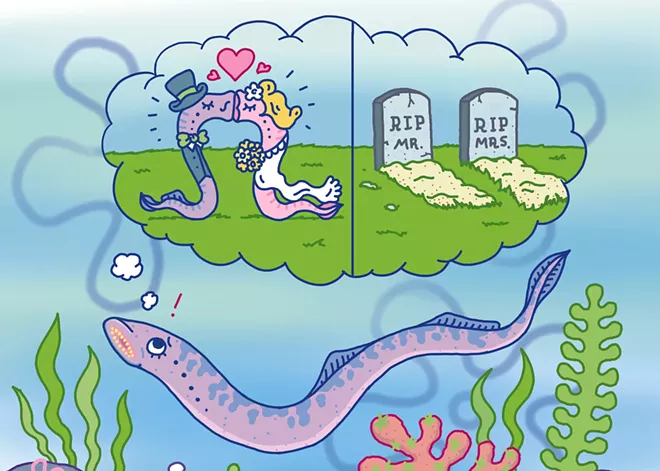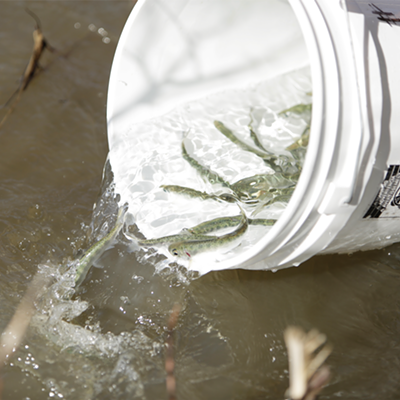According to Native American lore, Lamprey was an incorrigible gambler. On one fateful occasion, he challenged Suckerfish to the ancient guessing match of Stick Game. However, even when it became clear that luck wasn't on his side, Lamprey refused to cut his losses. By the time the sun rose the next day, he had lost everything he owned, right down to his bones. That's why Lamprey has no bones and no scales.
His legendary vices notwithstanding, tribes like the Umatilla, the Nez Perce and the Yakama remain drawn to the Pacific lamprey. The migratory, jawless eel-like fish, which has a skeleton made of cartilage rather than bone, has been important to their cultures for millennia for its nutritional and medicinal qualities.
Lampreys also play a significant ecological role by cleansing streams and acting as buffers to salmon predation. Even in death they have value, as other fish feed on their nutrient-rich decomposing bodies.
"They're a whole-system fish," says Lori Porter of the Columbia River Inter-Tribal Fish Commission.
Through a project that Porter leads for the fish commission, the organization has partnered with researchers at the University of Idaho to study Pacific lamprey in the hopes of understanding their maturation processes and finding sustainable ways to restore their natural populations.
Like salmon, the lamprey life cycle sees the fish transition from freshwater to ocean and then back to freshwater again to spawn. Also like salmon, their very existence is at risk because of this migration.
"The current evidence that we have in terms of when these fish appeared on the scene is about 500 million years ago. To put that into perspective, the dinosaurs came and went in just a blink of an eye compared to the time that this fish has existed in the waters of the Earth," says James Nagler, a professor of zoology in the Biological Sciences Department at the University of Idaho. "They're a fish that has stood the test of time. It's a survivor."
And yet, despite survival skills dating back to the Cambrian Period, the lamprey population has suffered in recent decades from anthropogenic threats like dams, pollution and climate change.
Since around 2000, regional tribes have engaged in radio tagging and translocation strategies that help the Pacific lamprey skip the most perilous points on the journey to its spawning areas upriver. But these interventions can be tricky because of variables that still need to be better understood.
"Right now, the tribes collect almost all their lamprey at the bottom of the fishway at Bonneville Dam, the lowermost hydroelectric project on the main stem of the Columbia River," Nagler explains.
This downstream capture typically takes place during the summer months, ahead of the mating process the following spring.
"For the aquaculture, or the propagation activity that they're doing, they'd like to know, well, how many males and how many females do we have?" Nagler says. "So they've been looking for a noninvasive means of sexing the fish — so that everybody has a date when spawning time rolls around."
Ultrasound imaging is one method that the researchers are using to determine each lamprey's sex and dial in the right gender ratios among fish who appear identical to the eye.
Assuming, however, that they were able to get an accurate fix on that, the lamprey life cycle poses yet another potential complication. It's called delayed maturation.
"This is a feature of their biology that's a little odd," he says. "When these fish migrate in, they appear to have two different strategies. Some of them are going to spawn the next spring, and some of them will actually stay in freshwater for almost two years. They'll basically skip a spawning cycle."
This means that the tribal aquaculture crews could be scooping up fish that won't aid their propagation efforts in the near term. As a result, they're now studying a blood-based hormone that might indicate whether the lamprey they've captured is ready to mate or will be abstinent for another year or more.
For Porter, "all this work is very critical and very timely," even if the lamprey's unsettling vampiric appearance has unfairly tainted it in the popular imagination: They have distinctive teeth. Instead, she sees the Pacific lamprey as a "charismatic" but "gentle" creature — one that's powerful and resourceful enough to ascend fish ladders with its mouth and also changes colors in line with its age and environment. Mysteries like the lamprey's swimming range or the guidance mechanisms it uses to return to its spawning areas continue to lend themselves to modern science as much as to ancient folklore.
And based on the trends Porter has observed, the knowledge gleaned from the translocation and artificial propagation projects is having a positive impact on Pacific lamprey populations. It's an important step on the way to making the species self-sustaining.
"The larvae are surviving," she says. "So we're celebrating the successes that we are seeing with increased numbers returning to some locations where they had been very low before."♦
























